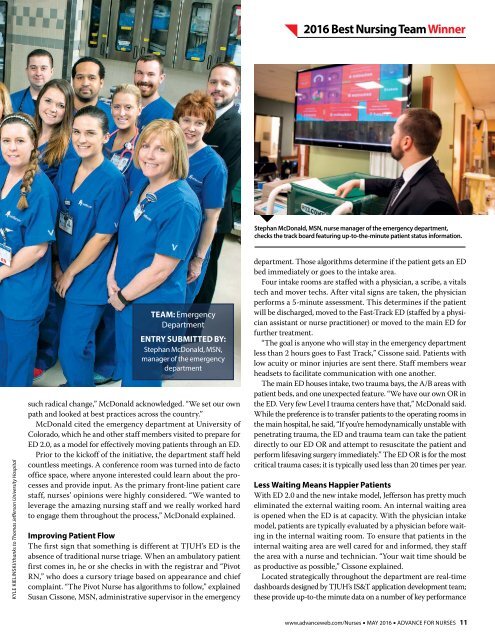You’re committed to your patients
4ntdB4
4ntdB4
Create successful ePaper yourself
Turn your PDF publications into a flip-book with our unique Google optimized e-Paper software.
2016 Best Nursing Team Winner<br />
Stephan McDonald, MSN, nurse manager of the emergency department,<br />
checks the track board featuring up-<strong>to</strong>-the-minute patient status information.<br />
KYLE KIELINSKI/thanks <strong>to</strong> Thomas Jefferson University Hospital<br />
TEAM: Emergency<br />
Department<br />
ENTRY SUBMITTED BY:<br />
Stephan McDonald, MSN,<br />
manager of the emergency<br />
department<br />
such radical change,” McDonald acknowledged. “We set our own<br />
path and looked at best practices across the country.”<br />
McDonald cited the emergency department at University of<br />
Colorado, which he and other staff members visited <strong>to</strong> prepare for<br />
ED 2.0, as a model for effectively moving <strong>patients</strong> through an ED.<br />
Prior <strong>to</strong> the kickoff of the initiative, the department staff held<br />
countless meetings. A conference room was turned in<strong>to</strong> de fac<strong>to</strong><br />
office space, where anyone interested could learn about the processes<br />
and provide input. As the primary front-line patient care<br />
staff, nurses’ opinions were highly considered. “We wanted <strong>to</strong><br />
leverage the amazing nursing staff and we really worked hard<br />
<strong>to</strong> engage them throughout the process,” McDonald explained.<br />
Improving Patient Flow<br />
The first sign that something is different at TJUH’s ED is the<br />
absence of traditional nurse triage. When an ambula<strong>to</strong>ry patient<br />
first comes in, he or she checks in with the registrar and “Pivot<br />
RN,” who does a cursory triage based on appearance and chief<br />
complaint. “The Pivot Nurse has algorithms <strong>to</strong> follow,” explained<br />
Susan Cissone, MSN, administrative supervisor in the emergency<br />
department. Those algorithms determine if the patient gets an ED<br />
bed immediately or goes <strong>to</strong> the intake area.<br />
Four intake rooms are staffed with a physician, a scribe, a vitals<br />
tech and mover techs. After vital signs are taken, the physician<br />
performs a 5-minute assessment. This determines if the patient<br />
will be discharged, moved <strong>to</strong> the Fast-Track ED (staffed by a physician<br />
assistant or nurse practitioner) or moved <strong>to</strong> the main ED for<br />
further treatment.<br />
“The goal is anyone who will stay in the emergency department<br />
less than 2 hours goes <strong>to</strong> Fast Track,” Cissone said. Patients with<br />
low acuity or minor injuries are sent there. Staff members wear<br />
headsets <strong>to</strong> facilitate communication with one another.<br />
The main ED houses intake, two trauma bays, the A/B areas with<br />
patient beds, and one unexpected feature. “We have our own OR in<br />
the ED. Very few Level I trauma centers have that,” McDonald said.<br />
While the preference is <strong>to</strong> transfer <strong>patients</strong> <strong>to</strong> the operating rooms in<br />
the main hospital, he said, “If you’re hemodynamically unstable with<br />
penetrating trauma, the ED and trauma team can take the patient<br />
directly <strong>to</strong> our ED OR and attempt <strong>to</strong> resuscitate the patient and<br />
perform lifesaving surgery immediately.” The ED OR is for the most<br />
critical trauma cases; it is typically used less than 20 times per year.<br />
Less Waiting Means Happier Patients<br />
With ED 2.0 and the new intake model, Jefferson has pretty much<br />
eliminated the external waiting room. An internal waiting area<br />
is opened when the ED is at capacity. With the physician intake<br />
model, <strong>patients</strong> are typically evaluated by a physician before waiting<br />
in the internal waiting room. To ensure that <strong>patients</strong> in the<br />
internal waiting area are well cared for and informed, they staff<br />
the area with a nurse and technician. “Your wait time should be<br />
as productive as possible,” Cissone explained.<br />
Located strategically throughout the department are real-time<br />
dashboards designed by TJUH’s IS&T application development team;<br />
these provide up-<strong>to</strong>-the minute data on a number of key performance<br />
www.advanceweb.com/Nurses n MAY 2016 n ADVANCE FOR NURSES 11


